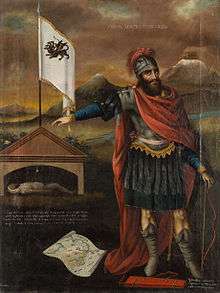Hayk
Hayk the Great (Armenian: Հայկ, Armenian pronunciation: [hajk]), or The Great Hayk, also known as Hayk Nahapet (Հայկ Նահապետ, Armenian pronunciation: [hajk nahapɛt], Hayk the "head of family" or patriarch[1]), is the legendary patriarch and founder of the Armenian nation. His story is told in the History of Armenia attributed to the Armenian historian Moses of Chorene (or Movses Khorenatsi, c. 410 - c. 490).
Etymology
The name of the patriarch, Հայկ Hayk, is not exactly homophonous with the name for "Armenia", Հայք Hayk’. Հայք Hayk’ is the nominative plural in Classical Armenian of հայ (hay), the Armenian term for "Armenian."[2] Some claim that the etymology of Hayk' (Հայք) from Hayk (Հայկ) is impossible[2] and that the origin of the term Hay ("Armenian") is verifiable.[2] Nevertheless, Hayk and Haig are usually connected to hay (հայ) and hayer (հայեր, the nominative plural in Modern Armenian), the self-designation of the Armenians. Armen Petrosyan believes that the name Hayk can "very plausibly" be derived from the Indo-European *poti- ‘master, lord, master of the house, husband’.[3]
Hayk would then be an etiological founding figure, like e.g. Asshur for the Assyrians, etc. One of Hayk's most famous scions, Aram, settled in Eastern Armenia from the Mitanni kingdom (Western Armenia), when Sargon II mentions a king of part of Armenia who bore the (Armenian-Indo-Iranian) name Bagatadi (which, like the Greek-based "Theodore" and the Hebrew-based "Jonathan," means "god-given").[4] Some sources claim that Hayk is derived from the Urartian deity Ḫaldi.[5]
Armenian historiography of the Soviet era connected Hayk with Hayasa, mentioned in Hittite inscriptions.[6]
The Armenian word Haykakan or Haigagan (Armenian: հայկական, meaning "that which pertains to Armenians") finds its stem in this progenitor. Additionally, the poetic names for Armenians, Haykazun (հայկազուն) or Haykazn (հայկազն), also derives from Hayk.
Genealogy
Moses of Chorene gave Hayk's genealogy as Japhet, Gomer and Tiras, Torgom. Hayk's descendants are given as Amasya, Ara, Aram, Aramais, Armanak, Gegham, and Harma.[7] Hayk was also said to be the founder of the Haykazuni Dynasty. According to Juansher, Hayk "was prince of the seven brothers and stood in service to the giant Nimrod (Nebrovt') who first ruled the entire world as king.[8]"
According to Moses of Chorene, the Armenian noble family, the Haykazunis, which included a number of legendary kings (such as Aram, Ara, Skayordi, Paryur, and Vahe), descended from Hayk.
Folklore
Hayk and King Bel

According to the accounts of Moses of Chorene and Sextus Julius Africanus, the battle occurred between the dynasty of Hayk and a Chaldean Dynasty in its third generation that had control of Babylon and the remaining territory of Akkadia under King Belus, a symbolic Babylonian/Akkadian God of War, or founder of Babylon depending on mythological tradition.[9]
In Moses of Chorene's account, Hayk son of Torgom had a child named Armanak while he was living in Babylon. After the arrogant Titanid Bel made himself king over all, Hayk emigrated to the region near Mount Ararat.[10] Hayk relocated near Mount Ararat with an extended household of at least 300 and settled there, founding a village he named Haykashen. On the way he had left a detachment in another settlement with his grandson Kadmos. Bel sent one of his sons to entreat him to return, but was refused. Bel decided to march against him with a massive force, but Hayk was warned ahead of time by Kadmos of his pending approach. He assembled his own army along the shore of Lake Van and told them that they must defeat and kill Bel, or die trying to do so, rather than become his slaves. In his writings Moses states that:
Hayk was a handsome, friendly man, with curly hair, sparkling eyes, and strong arms. He was a man of giant stature, a mighty archer and fearless warrior. Hayk and his people, from the time of their forefathers Noah and Japheth, had migrated south toward the warmer lands near Babylon. In that land there ruled a wicked giant, Bel. Bel tried to impose his tyranny upon Hayk's people. But proud Hayk refused to submit to Bel. As soon as his son Aramaniak was born, Hayk rose up and led his people northward into the land of Ararad. At the foot of the mountain he built a village and gave it his name, calling Haykashen.[11]
Battle of Giants and defeat of Bel

Hayk and his men soon discovered Bel's army positioned in a mountain pass (Moses of Chorene located the site as Dastakert), with the king in the vanguard.
At Dyutsaznamart (Armenian: Դյուցազնամարտ, "Battle of Giants"), near Julamerk southeast of Lake Van, on August 11, 2492 BC[12] (according to the Armenian traditional chronology of the first month of the Armenian calendar, Navasard or 2107 BC (according to "The Chronological table" of Mikael Chamchian), Hayk slew Bel with a nearly impossible shot using a long bow, sending the king's forces into disarray.
The hill where Bel with his warriors fell, Hayk named Gerezmank meaning "tombs".[13] He embalmed the corpse of Bel and ordered it to be taken to Hark where it was to be buried in a high place in the view of the wives and sons of the king.
Soon after, Hayk established the fortress of Haykaberd at the battle site and the town of Haykashen in the Armenian province of Vaspurakan (modern-day Turkey). He named the region of the battle Hayk, and the site of the battle Hayots Dzor.[14]
Comparative mythology
The figure slain by Hayk's arrow is variously given as Bel or Nimrod. Hayk is also the name of the Orion constellation in the Armenian translation of the Bible. Hayk's flight from Babylon and his eventual defeat of Bel, was historically compared to Zeus's escape to the Caucasus and eventual defeat of the Titans.[15]
See also
- Hayko
- Aram (given name)
- Belus (Assyrian)
- Nimrod
- List of Armenian patriarchs
- Armenian mythology
- Hayasa
- Armens
- Sisak (eponym)
References
- Gōsh, Mkhitʻar (2000). The Lawcode (Datastanagirk') of Mxit'ar Goš. Rodopi. p. 112. ISBN 9789042007901. Retrieved July 6, 2016.
- Moses of Khoren; Thomson, Robert W. (1978). "Genealogy of Greater Armenia". History of the Armenians. Cambridge, Massachusetts: Harvard University Press. p. 88. ISBN 0-674-39571-9.
- Petrosyan, Armen (2009). "Forefather Hayk in the Light of Comparative Mythology". Journal of Indo-European Studies. 37: 155–163.
- Lukenbill, Dave(1927) "Ancient Records of Assyria and Babylonia," p.28, The University of Chicago Press
- The heritage of Armenian literature. Hacikyan, A. J. (Agop Jack), 1931-, Basmajian, Gabriel., Franchuk, Edward S., Ouzounian, Nourhan. Detroit: Wayne State University Press. 2005 [2000]. pp. 65. ISBN 0814328156. OCLC 42477084.
Hayk, the legendary archer, has been part of Armenian culture and history since time immemorial. He was the primary god of the most prominent group of Urartian tribes, which eventually evolved into the Armenian nation. Hayk is considered the patriarch of the Armenians, and is indeed for this reason that Armenians call themselves Hay (pronounced haï). Hayk derives from the Urartian deity Khaldi, whose divide attributes he originally assumed with the constellation Orion. The well-known epic of Hayk's fight against Bell provides substantial proof that Hayk and his people stood up against Bel and halted the unrestrained influx of Semitic peoples from the south.
CS1 maint: others (link) - Eduard L. Danielian, "The Historical Background to the Armenian State Political Doctrine," 279–286 in Nicholas Wade, Armenian Perspectives (Surrey, UK, 1997) 279, citing E. Forrer, "Hajassa-Azzi," Caucasia, 9 (1931), and P. Kretschmer, "Der nationale Name der Armenier Haik," Anzeiger der Acad. der Wiss. in Wien, phil.-his. Klasse (1932), n. 1–7
- History 1.5
- The Georgian Chronicle
- Russell L.L.D., Rev. Michael (1865). A Connection of Sacred and Profane History. William Tegg. p. 334.
- Movses Khorenatsi, History of Armenia. Ed. by G. Sargsyan. Yerevan: Hayastan, 1997, pp. 83, 286.
- (Khorenatsi, History I.10–12, pp. 83–84.)
- dated by Mikayel Chamchian; Razmik Panossian, The Armenians: From Kings And Priests to Merchants And Commissars, Columbia University Press (2006), ISBN 978-0-231-13926-7, p. 106.
- Gerezmank: the nom. pl, Gerezmans being acc. pl., "tombs"
- History 1.11; a district to the southeast of Lake Van, see Hubschmann, AON, p.343
- Vahan Kurkjian, "History of Armenia," Michigan, 1968
Bibliography
- Ahyan, Stepan (1982). "Les débuts de l'histoire d'Arménie et les trois fonctions indo-européennes". Revue de l'histoire des religions: 251–271. doi:10.3406/rhr.1982.4670.CS1 maint: ref=harv (link)
- Petrosyan, Armen (2002), The Indo‑european and Ancient Near Eastern Sources of the Armenian Epic, Washington, D.C: Institute for the Study of Man, ISBN 9780941694810
- Petrosyan, Armen (2009). "Forefather Hayk in the Light of Comparative Mythology". Journal of Indo-European Studies. 37: 155–163. ISSN 0092-2323.CS1 maint: ref=harv (link)
- Petrosyan, Armen (2007). "The Indo-European *H2ner(t)-s and the Danu Tribe". Journal of Indo-European Studies. 35: 297–310. ISSN 0092-2323.CS1 maint: ref=harv (link)
- Petrosyan, Armen (2012). "Armenia and Ireland: Myths of Prehistory". Ireland and Armenia: Studies in Language, History and Narrative. Washington, D.C: Institute for the Study of Man. pp. 113–131. ISBN 9780984538386.
